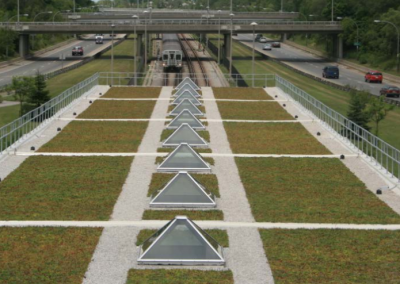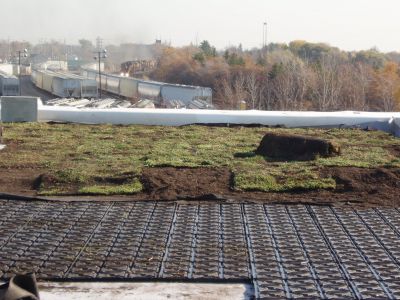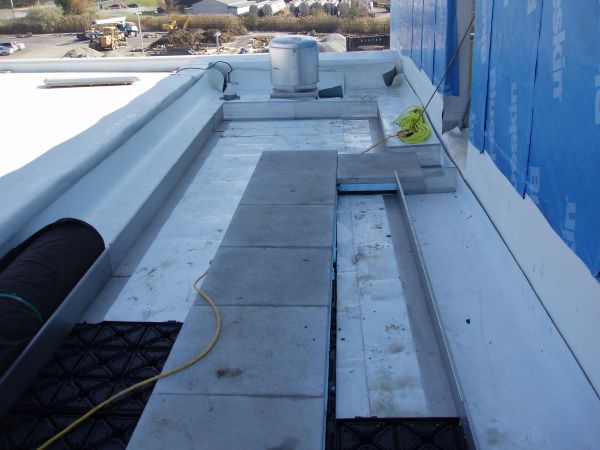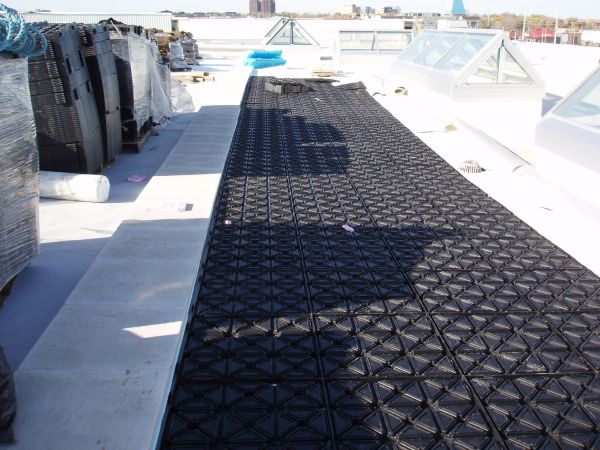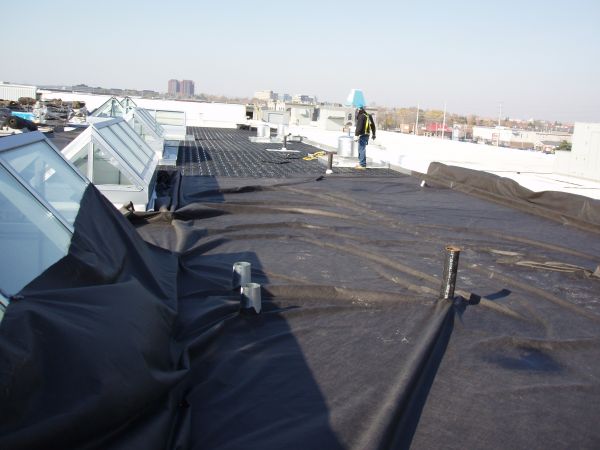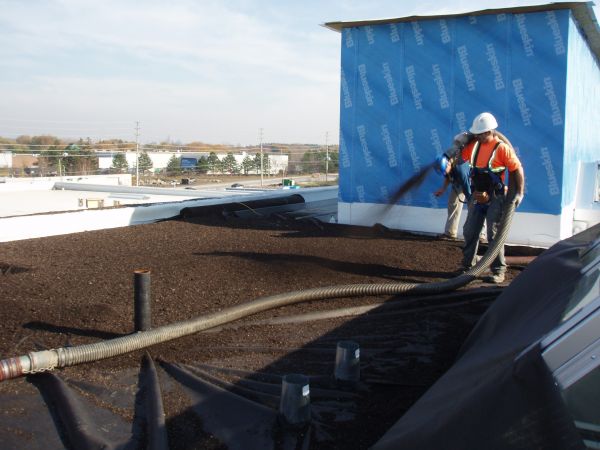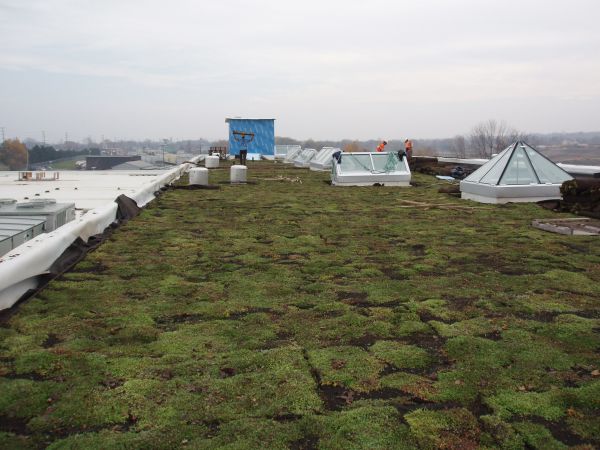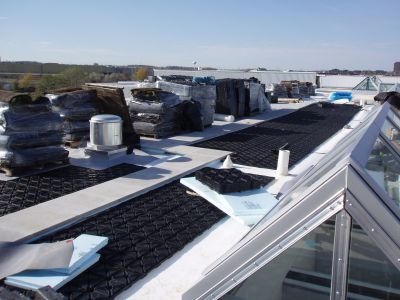Difference between revisions of "Green roof construction"
JamesCowan (talk | contribs) |
JamesCowan (talk | contribs) |
||
| Line 22: | Line 22: | ||
*[[Geotextiles|Filter fabric or geotextiles]]: are used to retain growing media and prevent migration out of green roof system | *[[Geotextiles|Filter fabric or geotextiles]]: are used to retain growing media and prevent migration out of green roof system | ||
*Growing media will vary according to the green roof system/product installed but is generally designed to be porous and lightweight with adequate fertility and drainage capacity to support plant growth and allow for absorption and infiltration of water. | *Growing media will vary according to the green roof system/product installed but is generally designed to be porous and lightweight with adequate fertility and drainage capacity to support plant growth and allow for absorption and infiltration of water. | ||
*Vegetation: Green roofs rely on vegetation (i.e., sedums/succulents, grasses, herbs, wildflowers and for intensive green roofs, shrubs and trees) to intercept, absorb and evapo-transpire stormwater. Vegetation can be installed as mats or as plugs or pots based upon the green roof design. | *[[Vegetation]]: Green roofs rely on vegetation (i.e., sedums/succulents, grasses, herbs, wildflowers and for intensive green roofs, shrubs and trees) to intercept, absorb and evapo-transpire stormwater. Vegetation can be installed as mats or as plugs or pots based upon the green roof design. | ||
*Overflow outlets: Flows exceeding the storage capacity of the BMP are conveyed to an adjacent drainage system via an overflow outlet structure and the roof drainage system. | *[[Overflow|Overflow outlets]]: Flows exceeding the storage capacity of the BMP are conveyed to an adjacent drainage system via an overflow outlet structure and the roof drainage system. | ||
*Irrigation System (if applicable): Most green roofs will require periodic irrigation, especially during the first 2 months of the establishment period. | *Irrigation System (if applicable): Most green roofs will require periodic irrigation, especially during the first 2 months of the establishment period. | ||
*Leak detection system (if applicable): leak detection systems should be used to periodically check for the presence of leaks in the water-proofing membrane. | *Leak detection system (if applicable): leak detection systems should be used to periodically check for the presence of leaks in the water-proofing membrane. | ||
Revision as of 13:03, 12 September 2022
Overview[edit]
Green roofs are composed of several layers (waterproof membrane or existing membrane, root barrier, drainage layer, filter fabric, growing medium) that support the growth of plants and other vegetation on top of a roof. Growing medium depth determines which plants can be planted, and the components of green roofs can either be loose-laid or fused together. The proper installation of green roofs can help to achieve water balance targets, promote biodiversity and provide green space.
Types[edit]
There are two main types of green roof systems: extensive and intensive.
- Extensive green roofs have growing medium depths of 10 cm to 15 cm (0.1 m to 0.15 m), maximum structural weight loads of 250 kg/m2, and vegetation is primarily limited to sedum spp or commonly known as stone crop. For information on plants that are often included in extensive green roofs, see this list.
- Intensive green roofs have growing medium depths greater than 15 cm (0.15 m), no maximum structural weight load. Intensive green roofs can be planted with deeply rooted plants, making them suitable for various native flowers, trees and shrubs. Pedestrian pathways and gathering areas can also be incorporated into the design of intensive green roofs.
Within these two types of green roofs are two installation type systems:
- Modular system: green roof component layers are fused together as a moveable modular block system that can be linked together with other green roof blocks to form the green roof. This type of system typically forms an extensive green roof type and are used where roofs are sloped and flat.
- Layered system: all components' layers are loose laid as individual layers. This type of system can form both extensive and intensive green roofs and used typically on flat roofs.
Component description[edit]
- Vegetation free zone: separates the green roof perimeter from the roof perimeter and other structures on the roof (e.g., vents), that is kept devoid of vegetation and natural debris.
- Root barrier: often a clear plastic sheet, the root barrier layer protects the water-proofing membrane from root penetration and degradation by microbial activity.
- Drainage layer: provides void space for excess water to drain from the growing media that is either stored for later uptake by plants or allowed to flow to roof drain.
- Filter fabric or geotextiles: are used to retain growing media and prevent migration out of green roof system
- Growing media will vary according to the green roof system/product installed but is generally designed to be porous and lightweight with adequate fertility and drainage capacity to support plant growth and allow for absorption and infiltration of water.
- Vegetation: Green roofs rely on vegetation (i.e., sedums/succulents, grasses, herbs, wildflowers and for intensive green roofs, shrubs and trees) to intercept, absorb and evapo-transpire stormwater. Vegetation can be installed as mats or as plugs or pots based upon the green roof design.
- Overflow outlets: Flows exceeding the storage capacity of the BMP are conveyed to an adjacent drainage system via an overflow outlet structure and the roof drainage system.
- Irrigation System (if applicable): Most green roofs will require periodic irrigation, especially during the first 2 months of the establishment period.
- Leak detection system (if applicable): leak detection systems should be used to periodically check for the presence of leaks in the water-proofing membrane.
Key construction steps[edit]
Modular system[edit]
- Sweep and blow the roof membrane clear and free of dirt, debris, and any sharp objects (such as flash clippings)
- Inspect the waterproof membrane for any potential damage prior to installing root barrier
- Install green roof perimeter or vegetation free zones (if applicable) a minimum 2 feet from parapet wall and around other critical infrastructure such as vents or roof drains
- Install the root barrier (if applicable) on top of the roof membrane.
- Ensure sheet is goes up the parapet wall the full height of the green roof system (if applicable).
- Where additional root barrier sheets are laid side by side, a minimum of 30 cm overlap between sheets is needed.
- Make appropriate slits in root barrier with a retractable knife (away from existing waterproof membrane) to allow installation around roof infrastructure such as drains, air vents and stacks
- Please note that modular systems often include a root barrier built into the system but some systems recommend doubling up
- Install the modular system according to manufacturer specifications or green roof design
- If modular system is installed on a slope roof, the system will need to be anchored according to manufacturer specifications or design
- Install irrigation system installation (if applicable) according to manufacturer specifications or design
- Backfill vegetation free zones with clear stone (if applicable)
Layered system[edit]
- Sweep and blow the roof membrane clear and free of dirt, debris, and any sharp objects (such as metal flashing clippings)
- Inspect the waterproof membrane for any potential damage prior to installing the root barrier
- Install green roof perimeter or vegetation free zones (if applicable) a minimum 2 feet from parapet wall and around other critical infrastructure such as vents or roof drains root free zone. Green roof perimeter may consist of metal edging which will be installed according to design and/or manufacturer’s specifications
- Install the root barrier (if applicable) on top of the roof membrane according to design or manufacturer specifications.
- Ensure sheet goes up the parapet wall the full height of the green roof system (if applicable).
- Where additional root barrier sheets are laid side by side, a minimum of 30 cm overlap between sheets is needed.
- Make appropriate slits in root barrier with a retractable knife (away from waterproof membrane) to allow installation around roof infrastructure such as drains, air vents and stacks
- Install drainage layers on top of the root barrier according to design or by manufacturers specifications
- Install filter layer according to design and manufacturer’s specifications. Ensure 30 cm overlap between adjacent rows and it runs up green roof edging (perimeter) the full thickness of the green roof
- Place green roof growing medium to specified depth within the design or manufacturer’s specifications. Growing media is typically blown onto the filter fabric layer by blower truck.
- Install plants and vegetation according to design
- If rolled vegetated mat system, take sedum clippings and infill sparsely vegetated areas
- Install irrigation system according to design and/or manufacturer’s specifications
Key inspection points[edit]
Construction inspections take place during several points in the construction sequence, specific to the type of LID BMP, but at a minimum should be done weekly and include the following:
- During site preparation, prior to BMP installation to ensure the roof structure is ready for green roof construction work and confirm that BMP layout area matches approved design drawings and that construction materials meet design specifications;
- After installation of leak detection system (if applicable) to ensure it was installed properly.
- At installation of water-proofing membrane (if a new build or membrane replacement), prior to installation of root barrier, drainage layer and overflow outlets to ensure it was done properly and to confirm that slopes are acceptable;
- After installation of root barrier, drainage layer (including filter fabric/layer) and overflow outlets, prior to installation of growing medium and plants to ensure it was done properly and confirm that depth and slopes are acceptable;
- After installation of growing medium layer and plants to ensure it was done properly and to confirm depth, slopes and elevations at overflow outlets are acceptable;
- After installation of irrigation system to confirm system is functioning;
- Prior to hand-off points in the construction sequence when the contractor responsible for the work changes (i.e., hand-offs between the building and green roof installation contractors);
- After large storm events (e.g., 15 mm rainfall depth or greater) to ensure roof drainage or flow diversion devices are functioning and adequately maintained.
Additional inspections may be needed depending on the number of layers in the green roof design (e.g., insulation, root barrier, and growing medium structural support layers) and may be required to comply with product warranty conditions. The green roof product vendor or designer should provide further guidance in this regard, specific to the system or product being installed.
Mistakes to avoid[edit]
- Green roofs should not be installed on roof slopes greater than 22 degrees or 40 %
- Green roofs should be ideally installed on new roof membranes, not on roofs that are older than 5 years or have noted leaks
- Green roof material storage should not exceed structural load of roof, spread materials evenly across the roof to ensure even load distribution
- Do not install vegetated mats with limited plant coverage. Mats should have a minimal plant coverage of 80 %
- Test and ensure green roof irrigation systems functions properly
